Round 7 Game 01: Kosteniuk pulls ahead in the Women’s final

Solid draws in Carlsen-Duda and Fedoseev-Karjakin Sunday, August 1st 2021 – After a well-deserved free day, the eight remaining players returned to the venue this afternoon to continue the fight for the 2021 World Chess Cup. They were joined on the stage by Polina Lion, Chief Sustainability Officer of ROSATOM, the largest producer of electricity in Russia, who played the first move in the women’s final. On board one in the open group, Norwegian World Champion GM Magnus Carlsen (2847), opened with 1.d4, and his opponent, Polish GM Jan-Krzysztof Duda (2738) opted for the Queen’s Gambit declined, starting with the 1…Nf6 move order. In other games here, Carlsen has preferred the Catalan opening but today he went for 4.Nc3 allowing 4…dxc4, transposing directly into a fashionable variation of the Queen’s Gambit Accepted, in which White sacrifices a pawn for development. Nothing new under the sun, of course: both players had already tested this line in the 2019 Tata Steel tournament. In that game, Carlsen emerged victorious. However, today he brought a new, and rather less-known, idea to the table. Duda decided to play it safe by giving the pawn back in order to reach an equal position albeit with an imbalance in the pawn structure and minor piece (knight against bishop). Although Carlsen tried his best to push for a win in the rook ending, Duda played with great precision and a draw was agreed just after move thirty. Before he left the venue to prepare for tomorrow’s game, Jan-Krzysztof gave us his thoughts in a brief interview. A fun fact occurred in the other all-Russian semi-final between GM Vladimir Fedoseev (2696) and GM Sergey Karjakin (2757). The former 2015 World Cup winner chose a very solid side-line in the Queen’s Gambit Semi-Tarrasch variation. Funnily enough, the same opening was being played a few metres away in the Women’s third-fourth place match! As luck would have it, both games deviated on move thirteen. The position remained equal for most of the game: neither player wanted to risk being essentially eliminated in the first game due to an unforced blunder. Soon enough, all the minor pieces were exchanged and some lengthy manoeuvring with the queen and rooks began. After more exchanges, Karjakin voluntarily went into a rook ending a pawn down, but in any case, a clear draw due to his passer. As top Russian GM Peter Svidler put it “Karjakin doesn’t lose many of these”. A draw was agreed on move sixty-nine. In his post-game interview, Fedoseev considered that he was pressing most of the game and that some of these rook endings can be won. In the all-Russian women’s final, between GM Aleksandra Goryachkina (2596) and GM Alexandra Kosteniuk (2472), the rules stipulated that Goryachkina would play with White in the first game. She opened with 1.d4 and soon the game followed the theory of the Catalan opening, one of her favourite set-ups. On move seven, 7.Be3 was definitely a surprise for Kosteniuk – 7.Bg5 and above all 7.e3 are by far the main moves – and she thought for nearly ten minutes before replying with the sensible 7…Nd5. She was able to keep the balance, in which her two bishops and optimal pawn structure compensated White’s extra space in the centre. However, fate struck hard on move twenty as 20…e5? was a big mistake. Obviously, 21.dxe5 would just return the blunder due to 21…Rd3 winning, but 21.b4! (after only two minutes of thinking time) was the perfect response. Goryachkina won a pawn and was clearly in the driving seat. She gradually increased her advantage and could have sealed the deal on move thirty-six if she had played 36.Rd1 intending Rd6 or Rd7, and Black is in big trouble. However, low on time, Goryachkina missed the win. With both players approaching move forty, huge complications commenced and this time Kosteniuk came out on top. Goryachkina – Kosteniuk Unfortunately for Kosteniuk, she threw away most of her advantage with 41…Qd4? (instead of either 41…c2 or 41…Qe3 which are both winning), but was lucky enough to get a second chance a few moves later when Goryachkina misplayed the ending, and this time she scored the win. In the match for third place between China’s GM Tan Zhongyi (2511) and GM Anna Muzychuk (2527), representing Ukraine, the Semi-Tarrasch variation of the Queen’s Gambit declined was played, just as in the men’s second semi-final. However, White’s 13.Bxf6 followed by 14.Nxd5 just didn’t have enough punch to achieve a serious advantage. After a few exchanges, Muzychuk spotted from afar the neat trick with 25…Nd4! and held the queen ending to a draw with no trouble at all. A good result for Muzychuk, who will now enjoy the white pieces in the second game tomorrow. Pairings of the rounds, live games and PGN files can be found on the World Cup website alongside a great amount of other interesting information such as daily videos, a complete photo collection and other useful data. Text: Michael Rahal, FIDE Press Officer press@fide.com Photo: Eric Rosen and Anastasiia Korolkova About the tournament: Scheduled to take place from July 12th (Round 1) to August 6th (finals), the 2021 FIDE World Cup will gather together in Sochi (Russia) 309 of the world’s best chess players, with 206 of them playing in the Open World Cup (and 103 participants in the first-ever Women’s World Cup. The top two finishers in the tournament, aside from World Champion Magnus Carlsen who is also participating, will qualify for the 2022 Candidates Tournament, in addition to winning the 110.000 USD first prize (80.000 USD for the runner-up). Organisers: International Chess Federation (FIDE), Chess Federation of Russia, Russian Ministry of Sports, and Government of Krasnodar Krai. Partners: Gazprom – general partner Nornickel – general partner PhosAgro – general partner Chessable – event’s partner Aeroflot – CFR’s partner Educational centre “Sirius”
Online Cadets and Youth World Cup 2021 kicks off on Tornelo
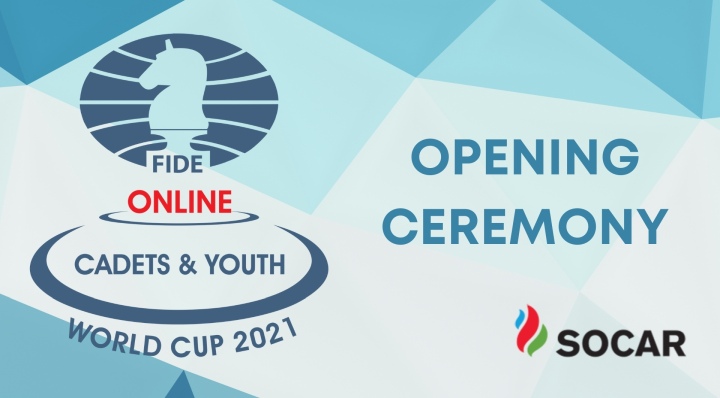
Online Cadets and Youth World Cup 2021 has started today. The qualifying stage tournaments will run until August 20, followed by finals on 26-31 August. More than 1600 participants from more than 100 national federations take part in the event. It is the first stage of the world championship cycle that also includes the Grand Prix series and culminates in a Super Final in December. The games are played online on Tornelo platform with substantive anti-cheating measures in place. FIDE Vice President Akaki Iashvili welcomed the players on behalf of FIDE and the Georgian Chess Federation: “Despite the global pandemic, FIDE moves forward with tangible results. Last year, we organized World Cadets and Youth Championships. This year, we have the world championship cycle, with World Cup, Grand Prix and Super Final in December.” “We wish you the best luck and to continue loving chess as you do. We rely on you as a new generation of players to come to the highest possible rankings in the next few years,” was the message to the participants from the FIDE President Arkady Dvorkovich. You can watch the opening ceremony here: https://www.youtube.com/watch?v=ijhFVu2KLEo The event is supported by SOCAR, the State Oil Company of the Azerbaijan Republic. You can find the results, regulations, and other information on the official website.
FIDE distributes an additional €37,500 among chess seniors
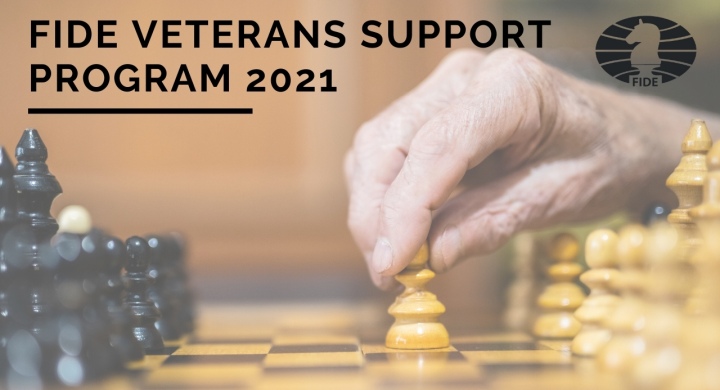
FIDE is pleased to announce the names of the additional fifteen chess seniors who will benefit from the FIDE’s support program to chess veterans this year: Andrei Lukin (RUS)Jan Plaсhetka (SVK)David Dzhanoev (GEO)Sergio Mariotti (ITA)Ewen Green (NZL)Svetlana Mednikova (RUS)Nathan Zilberman (KGZ) Mikhail Marandyuk (UKR)Tõnu Truus (EST)Khandsuren Sandagdorj (MGL)Nelson Borges (DOM)Luben Popov (BUL)Rakhil Eidelson (BLR)Silvino Garcia (CUB)Maria Macieja (POL) They will join the twelve recipients already announced back in March: Sergey Makarychev (RUS)Tamaz Giorgadze (GEO)Hanna Erenska-Barlo (POL)Roman Hernandez (CUB)Avigdor Bykhovsky (ISR)Juzefs Petkevich (LTV)Anatoly Noskov (KAZ)Bosko Abramovic (SER)Jan Kalendovsky (CZE)Nina Medyanikova (RUS)Julio Ostos (VEN)Irina Ostry (KGZ) Each one of them will receive a grant of €2,500, with the total amount allocated to this program during 2021 rising to an unprecedented €67,500. As we did in March and in other previous occasions, we will pay tribute to these illustrious veterans with a few words about each one of them, summarizing their careers and achievements: Andrei Lukin (Russia) International Master (1982), Master of Sports of the USSR (1966) and Honored Trainer of Russia, Andrei Lukin combined participation in chess tournaments with his job as an engineer for some time but later devoted himself to the profession of chess trainer. Andrei Lukin is a five-time champion of Leningrad (1972, 1978, 1981, 1983, 1988) and a prize winner of the Russian Chess Championship (1993). His best results in international competitions include Nałęczów (1981, 1st – 2nd place) and Leningrad (1984, 2nd-3rd place). As a part of the St. Petersburg chess team, he won the Russian Team Chess Championship (1992). He is also a medalist of the Russian Club Chess Championship (1995) as a member of the “University” team (St. Petersburg). Photo: Vladimir Barsky For his achievements in fostering many talented chess players, Andrei Lukin was awarded the title of Honored Trainer of Russia. Andrei Lukin trained grandmasters Konstantin Sakaev (until 1993) and Peter Svidler (since 1993). He headed the youth team of Russia at world tournaments, became the winner of the Russian Chess Federation “Coach of the Year” award. Peter Svidler attributed his breakthrough into the elite of world chess to his cooperation with Andrei Lukin and stated that he was lucky to have him as his chess trainer. Lukin also trained grandmasters Kirill Alekseenko (since 2008) and Anastasia Bodnaruk (since 2013). Jan Plachetka (Slovakia) Born on February 18, 1945, in Trencin (Czecho-Slovakia) Jan made his debut in the national championship in 1962 and soon joined the Chezco-Slovakian student team. After graduating from university, he climbed to the podium of the Chezco-Slovakian championship (1973) and became a member of the national team. Five years later he earned the grandmaster title. His tournament resume includes the victories in Rimavska-Sobota (1975), Polanica Zdrój (1975), Maribor (1977), Vincovici (1977), Sofia (1979), Champagnol (1984), Prague (1984), Strasbourg (1985), Metz (1986), but his glory moment came at the Olympiad in Luzern (1982). Jan turned in an excellent performance and helped his team to win silver. Overall he participated in Chess Olympiads (seven as player, seven as a team captain) Jan is making first move at Prague Chess Festival 2020 Photo: praguechessfestival.com/ FIDE Senior Trainer since 2010, he served as coach of men´s and women´s team of Slovakia in the period 1992 – 2014. With Plachetka at the helm, Slovak women were the European Champions in Batumi in 1999. A prolific author, Jan penned many articles in several chess magazines. David Dzhanoev (Georgia) David Dzhanoev (born on November 22, 1938, in Tbilisi) is one of the most successful chess trainers, working in Georgia (when it was a part of the USSR). He is most known as the coach of Nana Alexandria with whom he productively worked from 1977 to 1991. He also helped Gennady Zaichik, Sergei Movsesian and Giorgi Bagaturov (the Senior World Champion 50+) at different periods of their careers. After moving to Russia he coached Sanan Sjugirov, Pavel Shkapenko and Evgeny Reshetnikov. David lavishly shared his coaching experience consulting national teams of Bolivia, Ecuador, Syria and Columbia. Sergio Mariotti (Italy) Born in Florence (Italy) on 10th August 1946, Sergio Mariotti had quite a successful career in chess: after becoming Italian junior champion in 1964 (Turin), he won the international tournament in Naples in 1968-69 and became Italian champion for the first time in 1969 in San Benedetto del Tronto. One of his best tournament results is second place at the Venice international tournament in 1971 (behind GM Walter Browne and ahead of champions like GM Vlastimil Hort, GM Lubomir Kavalek and GM Svetozar Gligorić), also scoring his maiden GM norm. Sergio represented Italy at the Chess Olympiads in 1972, 1974, 1986 and 1988. At the 21st Olympiads in Nice (1974) he won the individual bronze medal on the first board and got my final GM norm, becoming the first-ever Italian chess player to get the title. British Chess Magazine nicknamed him “The Italian Fury”, referring to his enterprising, tactical style. Mariotti is still one of the most successful Italian players in World Championship cycles, winning the zonal tournament held in Caorle in 1975 and qualifying for the Manila Interzonal tournament of 1976, where he reached 10th place together with former World Champion GM Boris Spassky. Photo: novisad2017.org He served as President of the Italian Chess Federation (Federazione Italiana Scacchi – FSI) between 1994 and 1996, and later worked as a Technical Director (Direttore Tecnico) of Italian national teams between 2002 and 2007. A true ambassador of the game he has been supporting spreading chess across Italy and launching a long-term valorization process of Italian young talents. A milestone has been the creation of a team of young players for the 37th Chess Olympiad (Turin 2006), that represented the first opportunity for the new generation of Italian chess players to appear at the international level. Ewen Green (New Zeland) Born on April 4, 1950, Ewen Green represented New Zealand in World Under-20 Chess Championship in Stockholm 1969 and later played under the banner of his country at the 1970, 1974 and 1976 Olympiads. He participated in many NZ Championships jointly winning the 1979-80 New Zealand Championship and represented New Zealand again in the 1977 Asian Teams Championship and 1978 Zone 10 Championship in Japan.
$100,000 Chessable Masters gets underway
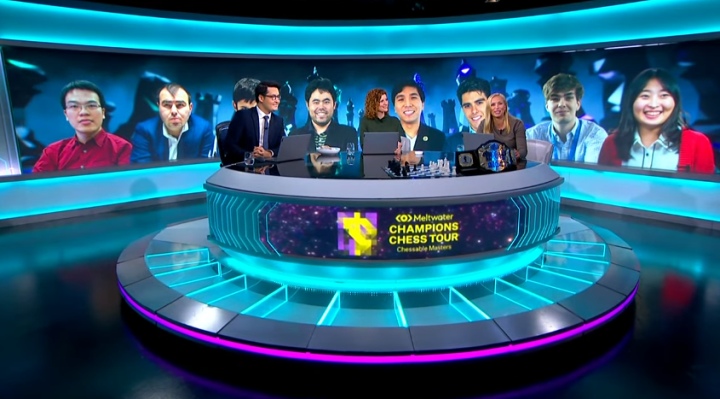
US star Wesley So is a half-point clear of the pack after the $100,000 Chessable Masters got off to a thrilling start today. The Fischer-Random World Champion, who is chasing the overall lead in the $1.6 million Meltwater Champions Chess Tour, scored three fine wins to finish on 4/5. Hot on his heels are fellow American Hikaru Nakamura, talented teen Alireza Firouzja and the Russian hotshot Vladislav Artemiev who all scored 3.5/5. The event’s 15-round prelim stage started with a huge interest in 12-year-old American prodigy Abhimanyu Mishra. Mishra is the world’s youngest Grandmaster having broken Sergey Karjakin’s long-standing age record last month. Mishra was making a big step up in class and was not expected to challenge, and it was predictably tough for the youngster. He suffered four successive defeats before picking up a draw in the final round against India’s Humpy Koneru. But Mishra, from Englishtown, New Jersey, wasn’t downbeat afterwards. “It’s an honour to play in this tournament, it is a very good learning opportunity for me,” he said. What wasn’t expected was that top seed Levon Aronian, the winner of the last Tour event, would have a catastrophic start. Aronian blundered away a winning position against the Dutchman Jorden Van Foreest and found himself on only half a point after three rounds. Two successive wins against Mishra and the Norwegian Aryan Tari got him back on track but the experienced Armenian still has a lot to do. The three-day prelim stage will resume tomorrow with rounds 6 to 10 before the cut is made on the final day and eight players are eliminated. All matches in the Chessable Masters are hosted in chess24.com’s playzone and available to watch on the platform’s Twitch and YouTube channels for free. The Chessable Masters is the penultimate leg of the Meltwater Champions Chess Tour before the Finals event in San Francisco, where the ultimate winner will be crowned the world’s best online chess player. For further information, please contact: Leon Watson, PR for Play Magnus Groupleon@chessable.com+44 7786 078 770
Sergei Karjakin “The Comeback Minister” advances to semi-finals

All-Russian women’s final between Goryachkina and Kosteniuk Friday, July 30th, 2021 – Although in the women’s group game two of the semi-finals were being played, most of the attention –online but also in the press room – was focused on the tiebreak match between GM Sam Shankland (2709), representing USA and GM Sergey Karjakin (2757), the Russian local hero. The winner would not only advance to the Open Group semi-finals but would also acquire a very decent shot at the 2022 Candidates qualification (there are two spots in play here). As usual, the tiebreak format is nerve-wracking; two 25 minutes + 10-second increment rapid games, followed by two 10/10 games. If there is still not a winner, two Blitz games 5/3 followed by a “sudden death” Armageddon game eventually decides the match. In the first 25/10 game, Shankland opened with 1.c4 but after a few moves the game headed down the paths of the Catalan Opening, a line that has a very solid reputation. Both players started their maneuvering tactics: for the most part, it seemed clear that they were playing it safe. The position remained balanced until Karjakin blundered with 33…Nc7? and then again with 36…Qd2? It’s always tricky for an annotator to suggest what he might have missed: maybe the 39.Bxc6 sacrifice, leaving White with two passed pawns and a clearly winning position. Karjakin defended as best as he could, but there was no way that Shankland was going to let this unique opportunity slip through his hands, and his endgame technique was more than enough to take the point home. Karjakin’s body language in the second game was unmistakably aggressive. After being crushed in the French in the classical games, Shankland brought back his beloved Sicilian but didn’t react well to White’s setup. Sergey Karjakin – Sam Shankland Already in the opening, 11…Qa5? was a big mistake, which Karjakin punished mercilessly with 12.f5! Again, it’s hard to know exactly where Shankland’s preparation was flawed – generally these mistakes happen due to mixing-up the different move-orders – but he was soon a piece down for two pawns. Karjakin wrapped-up the game and forced the second series of 10/10 rapids. Karjakin won the toss and played White again in the first of the two 10/10 rapids. On his tenth move he went for 10.e5 – home preparation – instead of 10.0-0-0, not expecting Shankland to repeat the same mistake twice. Kudos to his second Denis Khismatullin for preparing this idea during while the second game was being played! Shankland accepted the invitation, and after the exchange of queens he was a pawn up, but Karjakin had huge positional compensation and cashed in after a couple of dubious moves played by the American. Ahead on the score-cards, Karjakin chose the solid Queen’s Indian defence for the second 10/10 game. Although he was somewhat worse in a queen-rook endgame, his defensive skills came into play once again. With no other choice, Shankland over-pressed in the ending and “The Comeback Minister” qualified to the semi-finals. A very happy Sergey Karjakin gave us his thoughts on the match in a brief interview, cheered on by many supporters from the rail. After two draws in the first game, it was all on the line in the women’s section. Would GM Aleksandra Goryachkina (2596) from Russia, be able to take advantage of the white pieces and defeat her opponent, Ukrainian GM Anna Muzychuk (2527). What about the second game? GM Alexandra Kosteniuk (2472), playing for Russia, looked great in game one, seamlessly equalising with no effort at all in her game against GM Tan Zhongyi (2511) from China. How would the second game go, now that she would be playing with White. Goryachkina opened with 1.d4 and Muzychuk responded with the 10…Qa5+ / 11…Qa3 side-line in the Grunfeld defence, which had already been tried out here in the fifth round between Kateryna Lagno and Tan Zhongyi. Goryachkina spent quite a lot of time in the opening but found an interesting idea, isolating Black’s doubled pawns with a timely exchange of bishops on e6. Soon after, Muzychuk sacrificed a piece on d4 having calculated that she was getting it back with equality, but the idea was bad: Aleksandra Goryachkina – Anna Muzychuk Goryachkina could have won on the spot with 21.e5! but she chose 21.Rxb7 instead. After more than forty minutes of thought, Muzychuk opted for the exchange of queens, transitioning into a double-rook ending, which was slightly worse but defendable. However, Goryachkina piled on the pressure, played for the two weaknesses and notched up the win and the qualification to the Women’s World Cup final. Meanwhile, in the other semi-final game, Alexandra Kosteniuk surprised Tan Zhongyi with the so-called Keres-Kaufman attack against the solid Petroff Defence (5.c4). She achieved a small edge going into the middlegame, with a strong knight on b6 and two bishops pressuring the centre. Alexandra Kosteniuk – Tan Zhongyi Under serious pressure, Tan Zhongyi blundered with 19…dxc4? possibly missing that after 20.Rxc4 Qxa5 21.Ra4 Qb5 22.Be2! traps the queen. However, Kosteniuk had another idea in mind – to sacrifice her own rook for the opponent’s bishop on e6 after 22.Re1 Be6? 23.Rxe6 And it worked out! The former world champion from China was unable to find the best defence and eventually crumbled under the pressure. Although visibly tired after the huge effort, Alexandra still found time to attend to the press and give us her thoughts on the match and her qualification to the World Cup final. Tomorrow, Saturday, July 31st is the second free day. The World Cup Open semi-finals along with the Women’s final (and third-fourth place match) will begin on August 1st. More information on the World Cup website: Pairings of the rounds, live games and PGN files can be found on the World Cup website alongside a great amount of other interesting information such as daily videos, a complete photo collection and other useful data. Text: Michael Rahal, FIDE Press Officer press@fide.com Photo: Eric Rosen and Anastasiia Korolkova About the tournament: Scheduled to take place from July 12th (Round 1) to August 6th (finals), the 2021 FIDE World Cup will gather together in Sochi (Russia) 309 of
Chess for Protection: FIDE and UNHCR introduce a chess project for refugees
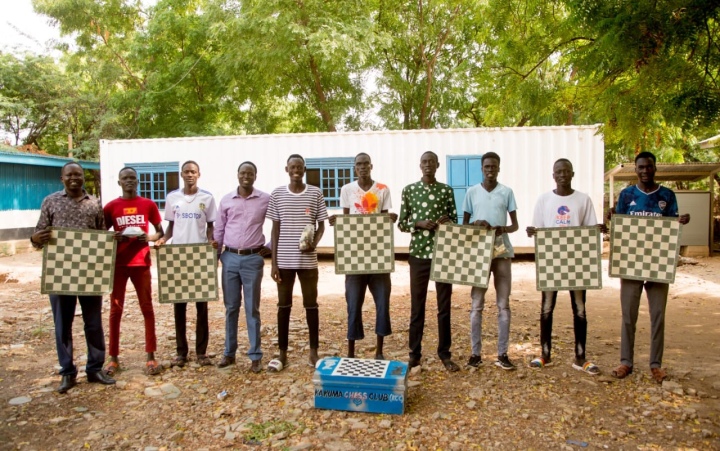
The Chess for protection project aiming to consolidate and develop the playing of chess in Kakuma Refugee Camp in Kenya starts on August 02. Chess often serves as a tool for empowerment that helps to enhance the psychosocial wellbeing of people, to reach their full potential, regardless of their background. The game can also make a huge impact in the lives of young people, giving them new learning opportunities and engaging in meaningful activities where they have a chance to heal, develop and grow. These are the aims of the Chess for protection project, implemented by the International Chess Federation, the UN refugee agency (UNHCR), Lutheran World Federation (LWF), Kenya Chess Federation and Kakuma Chess Club is expected to consolidate and develop the playing of chess in Kakuma Refugee Camp in Kenya. The kick-off event of the project starts on Monday, August 02 at 10:00 a.m. Kenya time (9:00 CET). It includes an online opening ceremony with key speakers such as UNHCR representative Fathiaa Abdalla, FIDE President Arkady Dvorkovich, Chess Kenya President Benard Wanjala and others and a simultaneous exhibition played between FIDE Managing Director Dana Reizniece-Ozola and members of Kakuma Chess Club. The arbiter at the simultaneous exhibition will be IA Shohreh Bayat. The program aims to raise awareness about the availability of chess as a sport including the opportunities it presents to talented players. It will also provide training to improve players’ knowledge and life skills which will, in turn, be passed to others. Linkages and networks will also be created with the larger chess community in Kenya and globally for greater development of chess in the camp and external opportunities for the professional development of players. Many young women and girls find it difficult to meaningfully engage in education and extra-curricular activities due to negative cultural norms that often prevent them from equal access to opportunities. Chess for Protection project includes activities of Girl Club Project under the leadership of FIDE Vice President Anastasia Sorokina, such as meeting and communicating with successful women, reading and discussing books, painting workshops and many others. Chess has been predominantly embraced by the youth from Kakuma and currently, 180 club members are actively participating in chess. Building on existing chess activities, the International Chess Federation will further bring in the experience and expertise of chess programs to contribute to the protection and well-being of refugee youth and adolescents and elevate chess to the level of key activities through which young people are engaged. The project is expected to directly benefit 1.600 learners, with various levels of chess proficiency through online presentations, provision of play materials and equipment, training and mentorship. Further, it is estimated that another 800 individuals from various parts of the camp community at large will be affected indirectly in various positive ways. Background Kenya is one of the biggest refugee-hosting countries in Africa and the world, hosting over 508,000 refugees mainly from the Great Lakes and Horn of Africa region. Over 40% of all refugees reside in Kakuma refugee camp. The majority of the refugee population in Kakuma and Kalobeyei consists of children and youth. Having been forced to flee from their homes, youth and adolescents are exposed to extreme stressors that may impact their psychosocial well-being. Further, 30% of children in primary school age and 94% at the secondary school age are out of school and not engaged in any income-generating activities, leaving them vulnerable to risks related to idleness such as developing stress, disorientation and hopelessness which predisposes them to engage in dangerous and risky behaviours – crime, violence, drugs, gang activities, and survival sex – as a means for coping with the situation. Further, many young women and girls find it difficult to meaningfully engage in education and extra-curricular activities due to negative cultural norms that often prevent them from equally accessing opportunities. They are expected to take care of family members while their parent/parents are working, which leaves them with very little time for learning opportunities.
Istvan Csom (1940-2021)
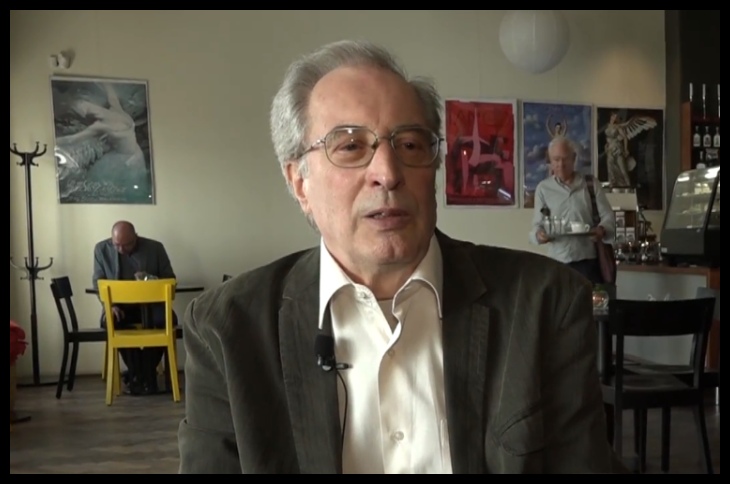
It is with the deepest sadness that we learned about the passing of GM Istvan Csom at 81. The Hungarian champion (1972 and 1973) he represented his country at nine Chess Olympiads. Istvan Csom won an Olympic gold medal with the Hungarian team in Buenos Aires 1978. He also took silver 3 times in Siegen (1970), Skopje (1972) and Valetta (1980) being the best scorer in the Hungarian team. He was a Hungarian Master Trainer and IA as well. Over the course of his career, Csom defeated many top grandmasters, including Mikhail Tal, Ulf Andersson, Boris Gulko, Antony Miles, Lajos Portisch, Samuel Reshevsky and Nigel Short. Famous for his legendary fighting spirit and fair play Istvan Csom became an icon of Hungarian chess. He will stay in our hearts. FIDE extends its sincere condolences to Istvan’s family, friends, and loved ones.
FIDE World Cup semis: Carlsen vs Duda
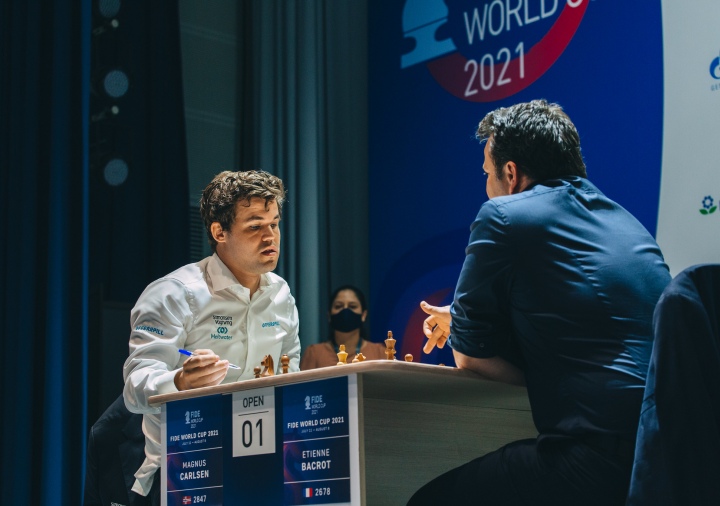
Both of the women’s semi-final games end in a draw Thursday, July 29th, 2021 – Yesterday evening, after the game, GM Etienne Bacrot (2678) representing France, expressed his feelings on Twitter. A rough translation would be something like “Magnus is too strong for me”. However, he came to the board with a fight in mind and lashed out 1…c5 – the ever-dangerous Sicilian defence. Unfazed, World Champion GM Magnus Carlsen (2847), from Norway, decided to play it safe, choosing the solid 3.Bb5+ side-line, as a draw would suffice for qualification to the semi-finals. Magnus Carlsen – Etienne Bacrot After the game, he confessed that he was slightly surprised with Bacrot’s choice of opening but the game remained approximately equal until Bacrot blundered with 31…Rxe4? which was promptly responded by 32.Ne7! After sacrificing the exchange Bacrot offered a draw which Carlsen declined. A better defence would have been 32…Qg4 when Carlsen was planning 33.Rxe4 Qxe4 34.Qf7! and after 35…Qe6 the World Champion evaluated the minor piece ending as clearly better although maybe not 100% winning. Don’t miss his post-game interview, in which Carlsen reveals this and much more! On board two, GM Sam Shankland (2709) from the United States, with a one-point advantage in the match, surprised former 2015 World Cup winner GM Sergey Karjakin (2757) from Russia by playing the French defence with Black, which he hardly ever uses. Karjakin took a deep breath, thought for a few minutes and responded with 2.d3 – the King’s Indian Attack – possibly trying to avoid running into Shankland’s home preparation. The game remained balanced until move twenty-one when Shankland went for 21…Na5 intending 22…Nc4. The more direct 21…a3 was probably necessary. Karjakin quickly forced his kingside breakthrough with 22.g5! and the attack was on. Sergey Karjakin – Sam Shankland After a few preparatory moves, he found a magnificent rook sacrifice – 27.Rxg7!! – and the game was soon over. These two players will return tomorrow for what will be a great tiebreak for the fans. Nonetheless, Karjakin found time to give us his insight on the game. While all of this excitement was taking place, Russian GM Vladimir Fedoseev (2696) was trying to grind his opponent down in a solid Catalan Opening on board three. He chose the 7.dxc5 variation, in which the queens are exchanged off the board very early. His opponent, GM M. Amin Tabatabaei (2613) from Iran, defended actively, and at no point seemed to be in trouble. Although Fedoseev did his best to try and unbalance a double-rook plus opposite-colored bishop ending, it was all to no avail and a draw was going to be the most likely result. But at the last minute the Iranian player, who has had a brilliant tournament, was eliminated by a huge blunder. Vladimir Fedoseev – M. Amin Tabatabaei Several moves would have secured the draw but 77…Rxg3?? was not one of them. After 78.Be5+ Kc6 79.Ra6+ Tabatabaei resigned as after 79…Kd7 80.Rd6+ Ke7 81.Rxe6+! Kxe6 82.f5+ wins a piece and the game. On board four, GM Jan-Krzysztof Duda (2738) from Poland, and GM Vidit, Santosh Gujrathi (2726) from India, played the most entertaining opening of the round. Pieces were flying around on the board, with sacrifices and counter-sacrifices at the speed of light. For many moves they were following a game played in 2013 between Adhiban Baskaran (2587) and Ashwin Jayaram (2461) – Adhiban was Vidit’s toughest match in Sochi – but it was clear that both players had studied the line in-depth as the balance was always maintained. Eventually, an approximately equal knight vs three pawns ending was reached. Jan-Krzysztof Duda – Vidit Santosh Gujrathi The game remained equal until move thirty-four. Just when it seemed to be heading for a draw Vidit blundered with 34…Re2? and after the very precise 35.Kh1 Duda was suddenly winning. It’s hard to suggest what Vidit might have missed, possibly the idea of playing 36.Ra1! before capturing the pawn on a6 with the knight. In his postgame interview, a very happy Duda affirmed that this was “the game of his life”. After their rest day, the semi-finals of the Women’s World Cup restarted with game one of the two-game match. On board one, GM Anna Muzychuk (2527) representing Ukraine, opened with 1.e4 against top seed GM Aleksandra Goryachkina (2596) from Russia. After ten theoretical moves in a Ruy Lopez opening side-line, Goryachkina decided to deviate from known theory with 10…Bg4 (instead of 10…Bf5 which has been played several times at the highest level). However, something went wrong – maybe 12…a5?! – as after a few more moves she had already dropped a pawn and things were looking very good for Muzychuk, who was enjoying a +2 advantage according to the main engines. But Goryachkina is a tough nut to crack. The precise defence combined with a few small inaccuracies and the double-rook ending was drawn on move forty-six. On board two, GM Alexandra Kosteniuk (2472), playing for Russia, equalised quite comfortably with Black against the Queen’s Pawn opening with fianchetto that her Chinese opponent GM Tan Zhongyi (2511) brought to the table today. A rather early exchange of queens lead to a blocked pawn structure in which Tan Zhongyi’s doubled f-pawn was compensated by the bishop pair and a bit more space. Both players maneuvered without much success and a draw was agreed on move thirty-one. The second game of the women’s section semi-final will be disputed tomorrow afternoon on the main stage while the men’s tiebreaks will be decided in the main playing venue hall. More information on the World Cup website: Pairings of the rounds, live games and PGN files can be found on the World Cup website alongside a great amount of other interesting information such as daily videos, a complete photo collection and other useful data. Text: Michael Rahal, FIDE Press Officer press@fide.com Photo: Eric Rosen and Anastasiia Korolkova About the tournament: Scheduled to take place from July 12th (Round 1) to August 6th (finals), the 2021 FIDE World Cup will gather together in Sochi (Russia) 309 of the world’s best chess players, with 206 of them playing in the Open World Cup (and 103 participants in the first-ever Women’s World Cup. The top two finishers in the tournament, aside from World Champion Magnus Carlsen who is also participating, will qualify for the 2022 Candidates Tournament,
Online Olympiad: Registration deadline approaching
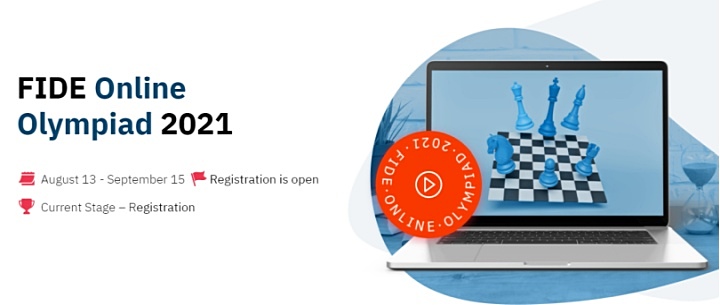
Just two days are left to confirm the participation and submit initial rosters for the 2021 Online Olympiad! Following multiple requests to extend the registration deadline from 31 July, FIDE has resolved that: 1. The deadline to confirm participation in the 2021 Online Olympiad remains 31 July. 2. The deadline to submit rosters via the online registration system remains 31 July. 3. Federations may change their submitted roster until 1200 UTC, 7 days before they are scheduled to play in the Online Olympiad for the first time, after which their squad composition will be fixed. This means the deadlines are as follows: Base Division Friday, 6th August 1200 UTC Division 4 Friday, 13th August 1200 UTC Division 3 Friday, 20th August 1200 UTC Division 2 Thursday, 26th August 1200 UTC Top Division Wednesday, 1st September 1200 UTC FIDE.com and the official website of the FIDE Online Olympiad (http://onlineolympiad.fide.com) will provide daily coverage of the event. The games will be broadcast live with multilingual expert commentary on the on the FIDE’s official Youtube channel and by Chess.com. Chess.com will be again the hosting platform for this event that, on its inaugural edition, became one of the highlights of 2020. With more than 1,500 participants representing 163 national teams, it was a truly global competition, very much in the spirit of the traditional chess Olympiads. It helped our big chess family to unite around a wonderful event at a time of crisis, when it was most needed. The second edition of the Online Olympiad will receive the support and sponsorship of the Shenzhen authorities, which include the Shenzhen Longgang District Culture and Sports Bureau, the Shenzhen MSU-BIT University, Shenzhen Chess Academy, Shenzhen Pengcheng Chess Club. Simaland, the Russian wholesale online store and proud sponsor of the Candidates tournament 2020-21, will also be a partner for the Online Olympiad 2021. Once again, the event will consist of two stages: the “Divisions stage”, and the Play-offs stage with the top eight teams qualified from Stage 1 battling in knockout format. Usually, at live Olympiads, the teams that can’t boast of the world’s best players in their lineups are not in the spotlight, as the general chess audience focuses on favorites. The unique format of the FIDE Online Olympiad gives us a chance to take a closer look at the teams bereft of chess stars but united by a sincere love for the game and a strong desire to develop and make progress. The qualifying format of tournaments in divisions also allows us to make some predictions and try to figure out the teams that will advance to the next stage. Tournament regulations (pdf) List of Teams by Starting Divisions (pdf)
Round 06 Game 01: One foot in the semi-finals for Carlsen
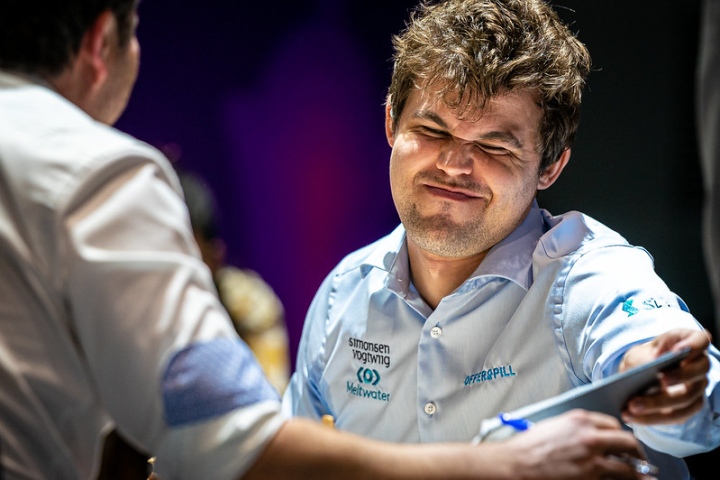
Shankland grinds down Karjakin in a technical ending Wednesday, July 28th, 2021 – Eight players returned to the Galaxy Centre this afternoon for Game 1 (of 2) of the sixth round of the World Cup: the quarter-finals. The stakes are really high: there is a lot in play. Not only the World Cup title and the fantastic 110.000 USD first prize: there are two spots for the 2022 Candidates tournament up for grabs, in addition to the direct qualification for the 2022 FIDE Grand Prix series. GM Emil Sutovsky (FIDE Director General) pinpointed an interesting fact on Twitter (edited): “Nobody would have guessed these eight (players). Notably, none of the five players that took part in the Candidates 20/21 tournament (Nepo and Ding didn’t play, Wang Hao quit afterwards). Well, that is a KO. And no, don’t call it a lottery!”. The women’s section enjoyed a well-deserved rest day today – it will be the open group’s turn on the 31st. Therefore, only four games were played, all of them very evenly matched. Board one – on the main stage – featured the match between GM Etienne Bacrot (2678) representing France, against World Champion GM Magnus Carlsen (2847) from Norway. Excluding blitz and rapid games (in which Bacrot has defeated Carlsen twice), the World Champion had a 6-3 track record in his favour, with no wins for Bacrot, and this statistic didn’t improve today. Carlsen played a very good game with Black, sacrificing a pawn for two bishops and the initiative in an anti-Marshall Ruy Lopez opening. Bacrot started to go astray with 24.f4?!, weakening his kingside, and a few moves later he blundered with 26.Qh3? (the move 26.f5 was better and the game goes on). Carlsen followed up by sacrificing his queen for a rook and a bishop in addition to a very strong passed pawn, and soon notched up the win and made his claim to advance to semi-finals. After the game, he analysed the different variations with GM Almira Skripchenko in the official commentator’s booth. On board two, USA top player GM Sam Shankland (2709) took on former 2015 World Cup winner GM Sergey Karjakin (2757), in the first official game between the two. After an earlier exchange of the queens, the game seemed to be heading for a draw, but Shankland did have some light-square pressure and chances to pressure a double pawn. Sam Shankland – Sergey Karjakin However, he needed a mistake and it finally came. Karjakin’s 38…f5?, allowing 39.e5, creating a strong supported passed pawn, was a game-deciding move. With excellent endgame technique and top-notch pawn-ending theoretical knowledge, Shankland was able to grind his opponent down. Sam was kind enough to share this thoughts of the game in a short interview. The former 2015 World Cup winner will now have to win tomorrow on-demand to force the tiebreak. GM Vladimir Fedoseev (2696), playing for Russia, was relatively happy with a draw with Black on board three. Both players castled queenside in a Queen’s Gambit – exchange variation -, but his opponent, GM M. Amin Tabatabaei (2613) from Iran, played for the attack on the queenside. Fedoseev sacrificed a pawn for some compensation, but Tabatabaei declined the offer and the Russian escaped unscathed. He gave us his thoughts in a brief post-game interview. Last but not least, the match between GM Vidit, Santosh Gujrathi (2726) from India and GM Jan-Krzysztof Duda (2738) representing Poland, will have to be decided tomorrow. Vidit went for a solid Catalan opening which gave him a very slight edge, two bishops and some squares for the knights, but Duda defended perfectly and the game ended peacefully on move 28. In the post-game interview, we questioned Vidit on his opening decision. More information on the World Cup website: Pairings of the rounds, live games and PGN files can be found on the World Cup website alongside a great amount of other interesting information such as daily videos, a complete photo collection and other useful data. Text: Michael Rahal, FIDE Press Officer press@fide.com Photo: Eric Rosen and Anastasiia Korolkova About the tournament: Scheduled to take place from July 12th (Round 1) to August 6th (finals), the 2021 FIDE World Cup will gather together in Sochi (Russia) 309 of the world’s best chess players, with 206 of them playing in the Open World Cup (and 103 participants in the first-ever Women’s World Cup. The top two finishers in the tournament, aside from World Champion Magnus Carlsen who is also participating, will qualify for the 2022 Candidates Tournament, in addition to winning the 110.000 USD first prize (80.000 USD for the runner-up). Organisers: International Chess Federation (FIDE), Chess Federation of Russia, Russian Ministry of Sports, and Government of Krasnodar Krai. Partners: Gazprom – general partner Nornickel – general partner PhosAgro – general partner Chessable – event’s partner Aeroflot – CFR’s partner Educational centre “Sirius”

